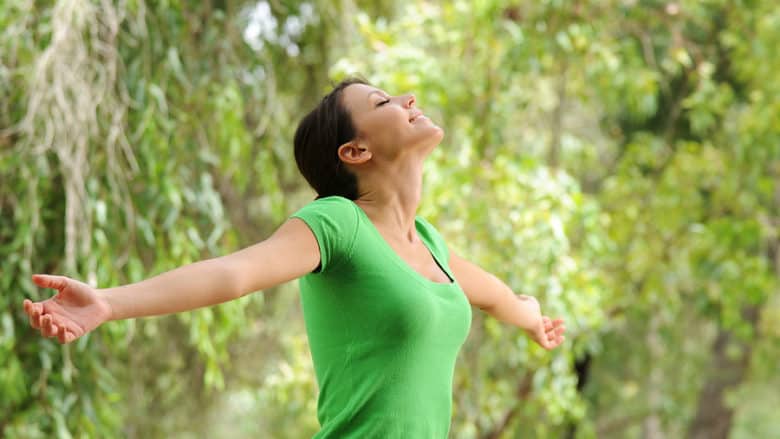
Nature therapy might seem too simple a way to improve your mood, immune system function, and maybe even decrease your chance of getting cancer. Yet, research studies suggests that although simple this therapy has real healing power.
What is Nature Therapy?
Japan, where this therapy is called forest therapy and forest bathing, leads the world in formally recognizing nature’s power to heal. The Japanese government has funded about $4 million to research its health benefits since 2004. Based on the positive findings of their research they developed 48 official forest therapy trails and some Japanese companies make nature therapy a part of their employee health plan.
“The Shinano Municipal Government of Nagano Prefecture, which manages the Iyashi no Mori (Healing Forest) forest therapy base has contracts with four companies,” reports Akemi NakaMura in The Japan Times News.
Nature therapy is a form of natural healing that consists of simply being in nature: a forest, park, or anywhere outdoors in a natural setting. Its one requirement is just to experience nature. For example:
• Smelling twigs of evergreen needles
• Hearing the sound of the wind and/or the songs of birds
• Feeling the sun or light breeze on your skin
• And, perhaps tasting a herbal tea, like ginger tea.
It is not focusing on how fast you can go, getting to the “ideal heart rate,”or how well you can do it. Nature therapy is simply enjoying being in nature. On the forest therapy trails of Japan, walkers are encouraged to take their time: to stop to look at a bird or the sky, to take a few deep breaths, and maybe even to develop their personal Haiku.
How Does It Work?
Nature therapy acts like an antidote to counter the negative effects of a world growing more and more technological, fast paced, and indoors.
For example, Americans spend at least eight hours a day looking at an electronic screen of some sort: computers, cell phones, TVs to name a few. Research suggests that this makes them more aggressive, anxious, and depressed, plus less nimble in their thinking, and well…fatter.
Leading forest therapy scholar, Yoshifumi Miyazaki, Director for Environmental Health and Field Sciences at Chiba University near Tokyo, says that even if we don’t know it, nature is where we are most comfortable because we evolved in it:
“Throughout our evolution, we’ve spent 99.9% of our time in natural environments…Our physiological processes are still adapted to it….a feeling of comfort can be achieved if our rhythms are synchronized with those of the environment.”
Miyazaki bases this understanding on hard science. One study he led measured cortisol (a stress hormone) in 260 people in 25 various settings. They found that those who gazed at forest scenery for 20 minutes had cortisol levels 13.4 percent lower than people in urban settings.
Other researchers continue to find significant health benefits of forest therapy. For example, researchers Q. LI and T. Kawada reports on their research:
Forest therapy acts on the endocrine system to reduce stress hormone levels such as urinary adrenaline, urinary noradrenaline, salivary cortisol, and blood cortisol levels and shows a relaxing effect. Forest therapy also acts directly and indirectly on the immune system to promote NK activity by increasing the number of NK cells and intracellular levels of anticancer proteins such as perforin, granulysin and granzymes. Taken together, forest therapy brings various effects on human health via the psycho-neuro-endocrino-immune network.
The International Society of Nature and Forest Medicine offers a small but impressive body of evidence on the importance of being in nature. These studies come from throughout the world: South Korea, Finland and Great Britain to name a few.
How to Get Started
Most importantly, remember that this is simple and easy. You just need to go outside more often. Take your time and experience nature…this is not a competitive sport. You get its benefits from simply experiencing the beauty and diversity of nature.
Li, one of the researchers above, provides a few recommendations on how to work more nature therapy into your lifestyle:
• Go to a natural area versus a city for vacation
• Get out in nature one weekend a month
• Visit a park once a week
• Work in the garden (or yard)
• On urban walks, walk under trees
• Go to quiet places (leave your music earphones behind)
• Being near water is good too
Key Points
This simple therapy can improve your mood, immune system function, and maybe even decrease your chance of getting cancer.
All you have to do is go outside and experience nature!
Nature Therapy Sources and Resources
Aaspinall,Peter, et.al. “The Urban Brain: analysing outdoor activity with mobile EEG,” British Journal of Medicine, published online March 5, 2013.
International Society of Nature and Forest Medicine at http://infom.org.
Nakamura, Aikemi, “‘Forest therapy’ taking root,” The Japan Times News, May 2, 2008.
Williams, Florence, “Take Two Hours of Pine Forest and Call Me in the Morning,” Outside Magazine, November 28, 2012.
